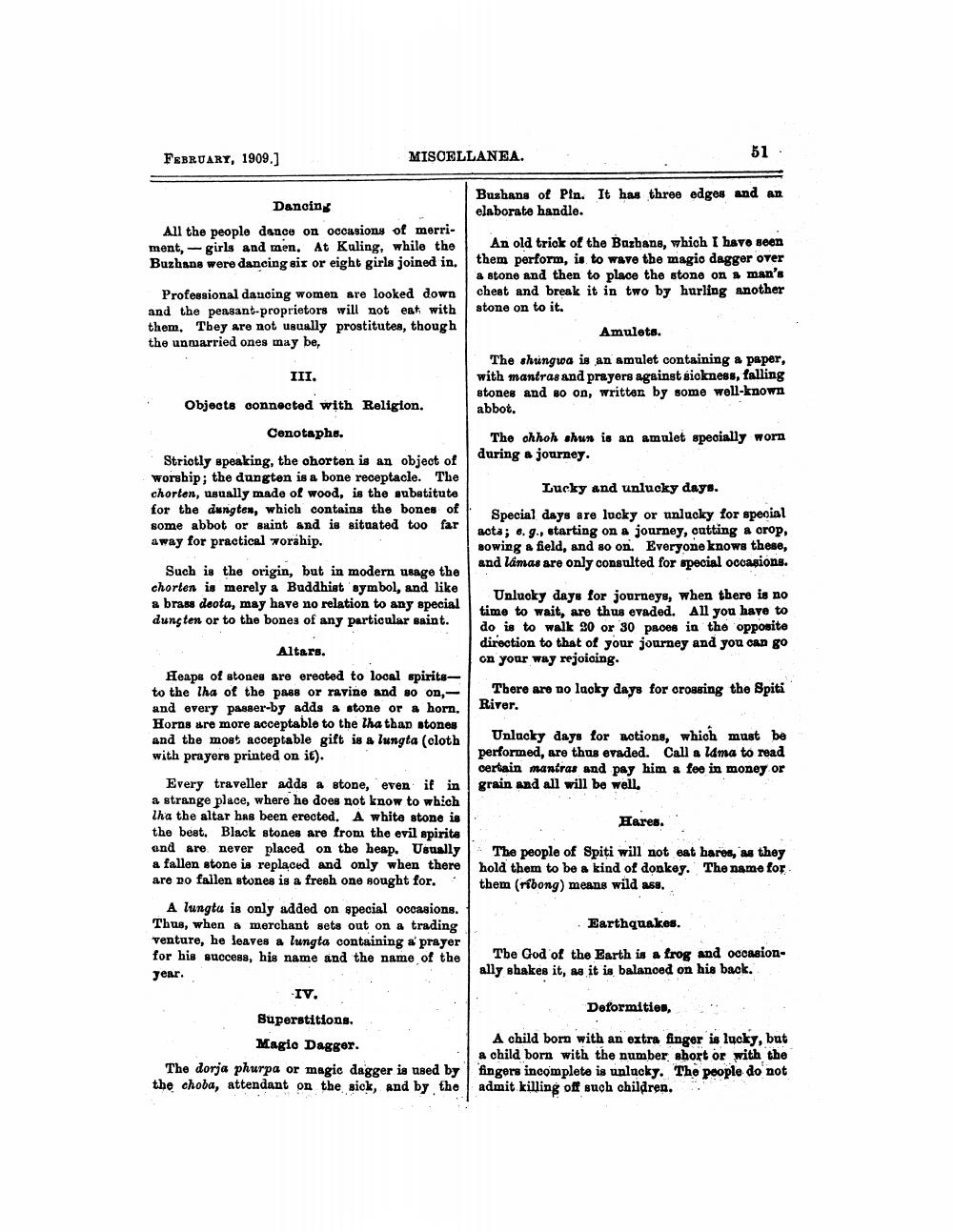________________
FEBRUARY, 1909.]
MISCELLANEA.
Dancing
All the people dance on occasions of merriment, girls and men. At Kuling, while the Buzhans were dancing six or eight girls joined in.
Professional dancing women are looked down and the peasant-proprietors will not eat with them. They are not usually prostitutes, though the unmarried ones may be,
III.
Objects connected with Religion.
Cenotaphs.
Strictly speaking, the chorten is an object of worship; the dungten is a bone receptacle. The chorten, usually made of wood, is the substitute for the dungten, which contains the bones of some abbot or saint and is situated too far away for practical worship.
Such is the origin, but in modern usage the chorten is merely a Buddhist symbol, and like a brass deota, may have no relation to any special dungten or to the bones of any particular saint.
Altars.
Heaps of stones are erected to local spiritsto the lha of the pass or ravine and so on,and every passer-by adds a stone or a horn. Horns are more acceptable to the tha than stones
and the most acceptable gift is a lungta (cloth
with prayers printed on it).
Every traveller adds a stone, even if in a strange place, where he does not know to which lha the altar has been erected. A white stone is the best. Black stones are from the evil spirits and are never placed on the heap. Usually a fallen stone is replaced and only when there are no fallen stones is a fresh one sought for.
A lungta is only added on special occasions. Thus, when a merchant sets out on a trading venture, he leaves a lungta containing a prayer for his success, his name and the name of the year.
-IV. Superstitions. Magic Dagger.
The dorja phurpa or magic dagger is used by the choba, attendant on the sick, and by the
51.
Bushans of Pin. It has three edges and an elaborate handle.
An old trick of the Buzhans, which I have seen them perform, is to wave the magic dagger over a stone and then to place the stone on a man's chest and break it in two by hurling another stone on to it.
Amulets.
The shungwa is an amulet containing a paper, with mantras and prayers against sickness, falling stones and so on, written by some well-known abbot.
The chhoh shun is an amulet specially worn during a journey.
Lucky and unlucky days.
Special days are lucky or unlucky for special acta; e. g., starting on a journey, cutting a crop, sowing a field, and so on. Everyone knows these, and lamas are only consulted for special occasions.
Unlucky days for journeys, when there is no time to wait, are thus evaded. All you have to do is to walk 20 or 30 paces in the opposite direction to that of your journey and you can go on your way rejoicing.
There are no lucky days for crossing the Spiti River.
Unlucky days for actions, which must be
performed, are thus evaded. Call a lama to read
certain mantras and pay him a fee in money or grain and all will be well.
Hares.
The people of Spiti will not eat hares, as they hold them to be a kind of donkey. The name for them (ribong) means wild ass.
Earthquakes.
The God of the Earth is a frog and occasionally shakes it, as it is balanced on his back.
Deformities,
A child born with an extra finger is lucky, but a child born with the number short or with the fingers incomplete is unlucky. The people do not admit killing off such children.




